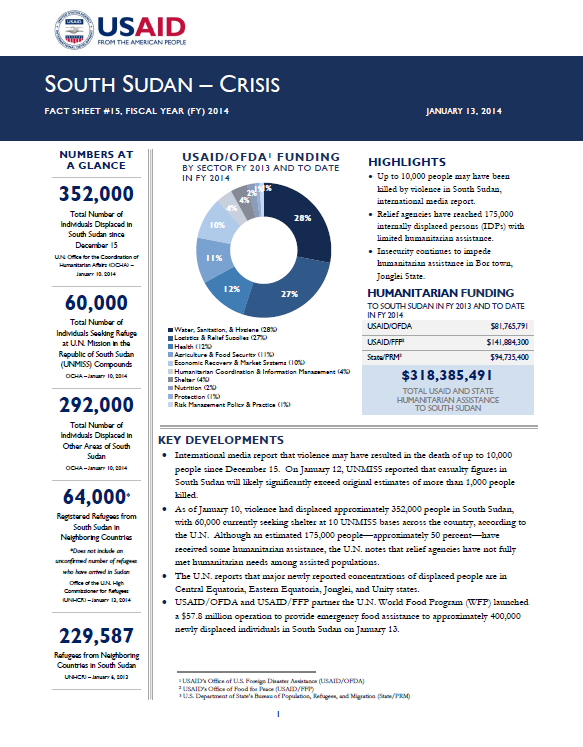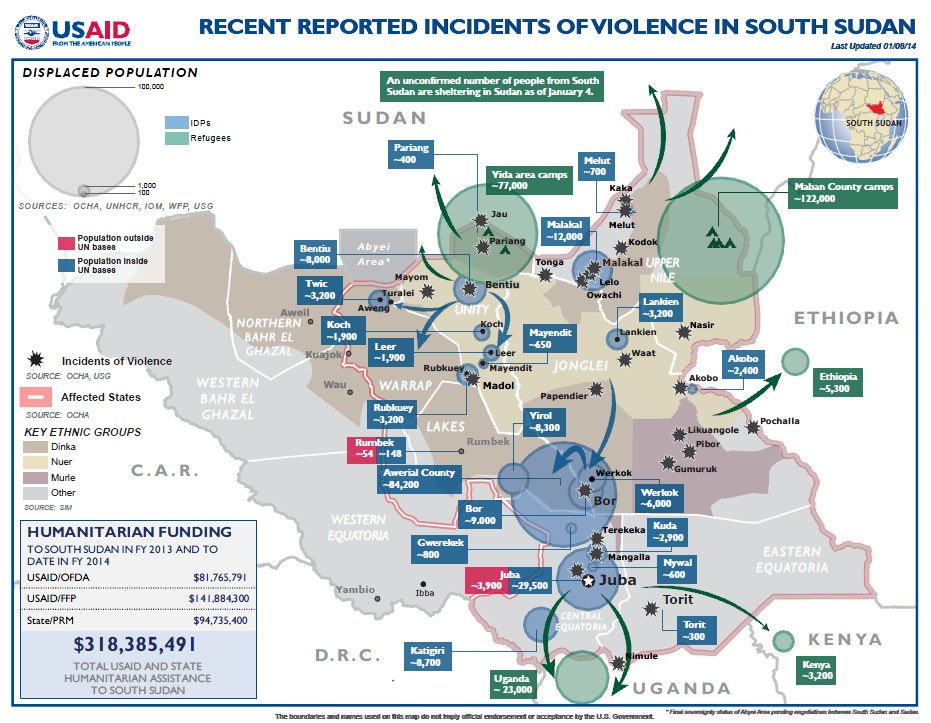- What We Do
- Agriculture and Food Security
- Democracy, Human Rights and Governance
- Economic Growth and Trade
- Education
- Ending Extreme Poverty
- Environment and Global Climate Change
- Gender Equality and Women's Empowerment
- Global Health
- Water and Sanitation
- Working in Crises and Conflict
- Disaster Assistance
- Political Transition Initiatives
- Conflict Mitigation and Prevention
- Countering Violent Extremism
- Disaster Risk Reduction
- Peacebuilding and Reconciliation
- Providing Safe & Secure Environments for Development
- Recovering From Crisis
- Resilience
- Tech Challenge for Atrocity Prevention
- World Humanitarian Day
- U.S. Global Development Lab
February 25, 2014
Numbers At A Glance
710,600
75,400
635,200
171,100
233,300
Humanitarian Funding:
To South Sudan To Date In FY2013 and FY2014:
| USAID/OFDA | $87,174,812 |
| USAID/FFP | $141,884,300 |
| State/PRMDoD | $94,735,400 |
| TOTAL | $323,794,512 |
Highlights
Ongoing clashes in Malakal town, Upper Nile State, force aid workers to evacuate.
U.N. human rights report underscores mounting international concern regarding the protection of civilians in South Sudan.
Health actors make gains on protecting communities from potential disease outbreaks.
KEY DEVELOPMENTS
Vulnerable populations continue to flee ongoing fighting in South Sudan, with violence displacing nearly 882,000 people—including both internally displaced persons (IDPs) and refugees fleeing to neighboring countries—since December 15, according to the U.N.
Heavy fighting between Government of the Republic of South Sudan (RSS) forces and opposition groups has persisted in Malakal since February 18, resulting in the death of more than 100 people, serious injuries, population displacement, and the evacuation of more than 80 humanitarian staff from the area. Relief agencies remain gravely concerned by unconfirmed reports of the deliberate targeting of civilians and increased incidents of sexual and gender-based violence conducted by armed actors in Malakal. Where possible, humanitarian actors are providing limited emergency relief to vulnerable populations.
Civilian protection concerns remain paramount in South Sudan due to persistent insecurity and conflict-induced displacement. Following a recent investigation of abuses against civilians, UNMISS reported that both RSS and opposition forces have deliberately targeted, killed, and forcibly displaced large numbers of civilians along ethnic lines, particularly in severely conflict-affected areas of Central Equatoria, Jonglei, Unity, and Upper Nile states. According to the U.N., witnesses have corroborated reports of extrajudicial and mass killings, forced disappearances, gender-based violence, and torture.
Although insecurity continues to constrain humanitarian access to conflict-affected areas, relief agencies have provided assistance to approximately 327,300 people since December 15.
SITUATION, DISPLACEMENT, AND HUMANITARIAN NEEDS UPDATE
Active hostilities continue to affect populations in Jonglei, Unity, and Upper Nile, with heavy fighting between RSS forces and opposition groups reported in Malakal and Gadiang town, located approximately 80 kilometers (km) north of Jonglei’s capital of Bor town. Population movements remain fluid in Jonglei, with fighting in Gadiang resulting in people fleeing from Bor to displacement sites in Awerial County, Lakes State.
As of February 25, the highest concentrations of displaced populations countrywide remained located in Unity, with approximately 182,000 IDPs, and Jonglei, with an estimated 129,300 people displaced.
While fighting continues in Jonglei and Upper Nile, tensions remain high in conflict-affected areas of Unity. Fears of potential hostilities in Unity’s capital of Bentiu town have prompted more than 1,000 people to seek shelter at the local UNMISS base in recent days, while relief agencies remain concerned by the looting and occupation of non-governmental organization (NGO) and U.N. compounds by armed actors in the town. The U.N. reports that Leer town, which was severely affected by hostilities in recent weeks, remains deserted despite the current absence of armed forces.
Most IDPs are experiencing Crisis—IPC 3—levels[1] of food insecurity in South Sudan, according to the USAID-funded Famine Early Warning Systems Network (FEWS NET). Market destruction and disruptions to harvests have resulted in significant food consumption gaps and severely restricted access to food, particularly in conflict-affected areas where traders have yet to return, including Bentiu, Bor, and Malakal. Meanwhile, insecurity has eroded traditional coping strategies, such as the consumption of wild foods and voluntary population migration to reach viable food sources. Although improved security conditions would increase trade flows and access to humanitarian assistance, FEWS NET reports that populations will likely face below-average food security outcomes regardless of security improvements during the April-to-August lean season due to significant obstacles impeding the resumption of market operations.
Overcrowding at IDP sites continues to pose significant public health risks according to relief agencies. The potential spread of communicable diseases, in particular, is raising concern among humanitarian health actors as the lack of shelter in most IDP sites increases the risk of respiratory infections and malaria. In addition to physical injuries and psychological trauma, measles, diarrheal diseases, and malaria remain the main health conditions of concern among vulnerable populations.
South Sudan Crisis Fact Sheet #30 February 25, 2014 ![]() (pdf - 370k)
(pdf - 370k)
South Sudan Crisis Map February 25, 2014 ![]() (pdf - 959k)
(pdf - 959k)
HUMANITARIAN RESPONSE ACTIVITIES
Although humanitarian organizations have reached approximately 327,300 people with humanitarian assistance since hostilities erupted on December 15, relief agencies have not fully met needs among assisted populations due to insecurity and a lack of sustained, predictable access, according to the U.N. Among those assisted, approximately 166,500 people have received medicines and medical consultations, while measles and polio vaccination efforts have reached nearly 220,000 children. Nearly 279,000 people have received emergency food assistance.
In advance of the April-to-August rainy season, relief agencies are prioritizing contingency planning efforts, improving living conditions at UNMISS bases, reducing the risk of water-borne diseases, and pre-positioning relief commodities and water, sanitation, and hygiene (WASH) supplies in key locations.
The U.N. World Health Organization (WHO), a USAID/OFDA partner, is working to provide cholera vaccinations for approximately 140,000 people in Juba town, Central Equatoria, and Awerial. Although cholera has not affected populations in South Sudan since the conflict started on December 15, overcrowding and poor sanitation conditions place vulnerable communities at risk of disease outbreaks, prompting relief agencies to implement measures to mitigate these risks. First-round vaccination activities aim to protect 94,000 IDPs and host community members in Awerial’s Mingkaman town, as well as more than 43,000 IDPs at the two UNMISS bases in Juba—Tong Ping and U.N. House 3. As of February 24, relief agencies had delivered more than 250,000 oral cholera vaccine doses to South Sudan to facilitate first- and second-round vaccination efforts.
With several measles vaccination campaigns underway or recently completed in displacement sites across South Sudan, the overall number of suspected measles cases declined significantly during the week of February 17, decreasing by nearly 60 percent from the previous week, the U.N. reports. In particular, reported measles cases have decreased in Juba’s Tong Ping and U.N. House 3 sites as health care and hygiene promotion interventions continue. However, the threat of measles outbreak in IDP sites remains as unpredictable security conditions, fluid population movements, and overcrowding at IDP sites continue to impede inclusive vaccination coverage and robust health care activities.
Since February 21, humanitarian agencies delivered nearly 34 metric tons (MT) of life-saving relief commodities via air and road transport to eight NGOs operating across South Sudan. When security conditions stabilize and humanitarian flights resume, humanitarian actors plan to deliver an additional 25 MT of relief supplies to organizations responding to urgent needs in Malakal.
Central Equatoria
Relief agencies continue to provide primary health care services, health education interventions, and hygiene promotion activities in Tong Ping and U.N. House 3, resulting in increased willingness among displaced communities to seek and receive critical health care support. The Health Cluster—the coordinating body for humanitarian health activities, comprising U.N. agencies, NGOs, and other stake holders—reports that these health-seeking behaviors are key to proactively treating illnesses and preventing disease outbreaks, particularly in overcrowded areas.
Jonglei
In early February, the U.N. Children’s Fund (UNICEF) and WHO completed nutrition screenings for all children under five years of age in the Bor UNMISS base. To ensure continued support for malnourished individuals, humanitarian organizations distributed Plumpy’Nut—a high-calorie nutritional supplement—to vulnerable IDPs and have treated more than 100 severely malnourished children at the base’s outpatient therapeutic feeding center.
Following reports of suspected measles cases in Walgak town, Akobo County, Jonglei, Médecins Sans Frontières conducted assessments and helped launch vaccination activities. As of February 24, relief agencies had provided vaccinations to nearly 10,200 children.
Relief agencies are working to conduct security risk assessments in Duk, Pibor, Pochalla, and Twic East counties to analyze potential challenges to reaching vulnerable communities and enable humanitarian organizations provide assistance to populations located outside Bor.
Lakes
Relief operations continue for the estimated 74,000 IDPs sheltering in Mingkaman town, Awerial County, Lakes State. While IDPs continue to arrive in Mingkaman, the rate of arrival has declined in recent weeks, according to the U.N. The International Medical Corps (IMC) continues to provide primary health care services to IDPs sheltering near and in Mingkaman town through one static clinic and two mobile medical units. In coordination with other health agencies, IMC plans to establish an additional mobile medical unit to benefit IDPs in the coming days.
The Norwegian Refugee Council is currently distributing emergency shelter kits and household kits—including blankets, cooking sets, mosquito nets, and soap—to approximately 30,000 IDPs in Mingkaman.
Unity
Relief agencies continue to provide primary and reproductive health care services for more than 3,400 people located at the UNMISS compound in Bentiu, where security conditions remain tense but relatively stable. During the week of February 17, health actors provided consultations for more than 2,500 people, including individuals who returned to Bentiu in recent days. Humanitarian organizations are providing nutrition screening and treatment services but require the establishment of a stabilization center for individuals experiencing severe acute malnutrition.
In response to an interagency assessment identifying humanitarian needs among an estimated 25,000 IDPs located in Panyijar County, Unity, relief agencies are implementing multi-sector response activities—including shelter and WASH interventions—during the week of February 24.
Upper Nile
Despite ongoing fighting, relief agencies are providing essential services in Malakal and the local UNMISS base. Humanitarian organizations are arranging the safe movement of an estimated 1,700 people in the town—as well as the evacuation of extremely vulnerable individuals from the hospital in Malakal—to the UNMISS site.
In addition to working to ensure the safety of vulnerable civilians in Malakal, the WASH Cluster has repaired water containers and pipelines in the Malakal UNMISS base, improving access to safe drinking water for more than 20,000 IDPs sheltering at the base. Relief agencies have also distributed more than 72 MT of food rations to approximately 5,000 people since February 22, with distributions ongoing.
Humanitarian actors are working with UNMISS to secure equipment and space for an additional IDP site at the Malakal UNMISS base to accommodate up to 5,800 people, as well as exploring additional options for mitigating overcrowding in the compound.
OTHER HUMANITARIAN ASSISTANCE
To date, international donors have provided approximately $260 million—or nearly 20 percent of the $1.27 billion total requested funding—to support humanitarian activities through the South Sudan Crisis Response Plan. Although relief agencies have received an additional $20 million in pledges, the U.N. reports that additional funding is needed to efficiently implement life-saving services and secure relief commodities for all core pipelines.

*Funding figures are as of February 25, 2014. All international figures are according to OCHA’s Financial Tracking Service (FTS) and based on international commitments during the 2013 and 2014 calendar years. USG figures are according to the USG and reflect the most recent USG commitments based on the 2013 fiscal year, which began on October 1, 2012, and ended September 30, 2013, as well as the 2014 fiscal year, which began on October 1, 2013.









Comment
Make a general inquiry or suggest an improvement.